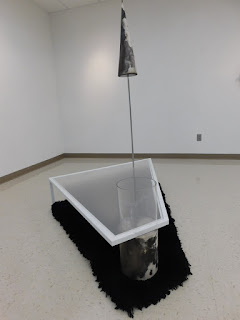Meet me at the corner of stasis and flux
By Tom Wachunas
EXHIBIT: no place is perfectly round - Sculpture
installations by Jonas Sebura and Emily Duke / at Main Hall Art Gallery, Kent
State University at Stark, 6000 Frank Avenue NW, North Canton, Ohio / THROUGH
DECEMBER 1, 2017 (Closed November 10, 23-26) / Viewing hours Monday-Friday 11
a.m - 5 p.m.
This
exhibit is very much about place. I’m
talking, first, about the cerebral locale we inhabit wherein we can be wholly
mindful of our present moment in a specific setting. And secondly, while in
that moment, are we willing to seek and go to a unique somewhere in our own experience, cued by the articulated materials
placed before us?
Both Jonas Sebura
and Emily Duke are Fine Arts faculty members at Kent State University’s main
campus – he an Assistant Professor (Sculpture), she an Adjunct Professor (Ceramics).
The separate sculptural works here are not outright collaborations between the
two artists. Yet viewed collectively, there’s harmony in how their pieces
converse with and otherwise complement each other as conceptual and material
entities.
The three intriguing
works from Jonas Sebura are imbued with a spirit of performative geomancy –
that ancient and mystery-shrouded practice of divination through the placement
(or place-ness) of lines or figures and forms within a geographic context.
Here, that geographic component takes the symbolic form of low-lying, white
polygonal tables, or planes, upon which his sculptural elements interact in
varying states of balance and tension. They suggest the passage of time, a
feeling of impending motion, or forward progression, as in “The Approximation
of What Is and What Could Be.” On one end of the table, there’s a concrete
fossil of a footprint, and on the other a mold of the foot itself. A journey
undertaken.
The slick, black,
monolithic forms in his “Landscapes and Lay Lines” might be impenetrable totems,
or mute sentinels of vexing, unknowable things. There’s a cryptic element of
arrested animation in the form of a tiny jewel-like bauble dangled from a hand
attached to a tree branch… all of it seemingly presided over by a startling
mask made from resin-cast teeth and mounted atop a thin upright rod. Ruminating
on angst?
While Sebura’s
pieces exude an improvisatory, lyrical theatricality, the five works by Emily Duke
are relatively more calculated designs that evoke a tranquil domesticity. The
starkly handsome coffee table arrangement in “Matching Suite” is a facile
balancing of horizontality and verticality, as well as textures. Looking down
through the tinted glass top of the table, the shaggy black yarn of the rug
below becomes a muted grey plane subtly echoing the smoky surface of the narrow
conical form – call it a lamp shade - hovering above.
A similar
playfulness transpires in “The Flavor of My Private Identity.” The physicality of the hanging towels gets
slyly undermined when you find that their presumed soft, fluffy texture is
illusory - a printed image, not actual fluffiness. I’m reminded that a
constructed illusion or facsimile of a place (in this instance, a wall in a
bathroom), though perhaps a memory, is still a unique somewhere in real time and on its own terms. In veiling the
actuality of the towels’ texture, the mimetic formality of this tableau becomes
a fascinating metaphor, or mental place, for considering the nature of privacy.
As discrete units, the artworks in this
exhibit certainly give us a sense of individualized aesthetic approaches and/or
personal identities of the artists. In this context, you might think of Emily
Duke in the role of a structural engineer, perhaps even a mathematician, and
Jonas Sebura as an alchemist. She creates elegantly prosaic counterpoints to
his mystical, brooding poetics. That said, together they’ve made the gallery
into a unified tableau of contrasts, or dualities: density and transparency,
reflective and opaque, smooth and coarse, organic and geometric, personal and
public, literal and metaphorical.
And then there’s
brain-teasing title of this exhibit. What might “no place is perfectly round”
really mean? Is it a literal statement of fact, or some sort of riddle?
I could read ‘no
place’ in the objective or quantitative sense, as in, “There is no such thing
as a perfectly round place.” Or I could
regard it in the qualitative, subjective sense, meaning any location I find to
be undesirable, as in, “This perfectly round house is no place, man.” No place might then be anyplace I don’t like
or want to visit. So then, is no place a variant of nowhere? But in that case,
isn’t nowhere just a squeezing together of words which might mean that I’m
actually… now here?
I guess dwelling in these elliptical
considerations has taken me nowhere fast to a perfectly challenging place. And
for those viewers among us who actively savor such challenges, this show is
just the place to be.
PHOTOS, from top: (1.)The
Approximation of What Is and What Could Be, steel, wood, concrete, resin,
crystals and sea shells, by Jonas Sebura / (2.)
Landscapes and Lay Lines, steel,
resin, wood, concrete and sea shells, by Jonas Sebura / (3.) detail from Landscapes
and Lay Lines / (4.) The Flavor of My Private Identity, stoneware,
printed silk Charmeuse, plexi-glass, thread, grout & wood, by Emily Duke / (5.) Matching Suite, pit-fired stoneware, steel, plexi-glass, tempered
glass and acrylic yarn, by Emily Duke





No comments:
Post a Comment